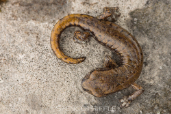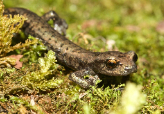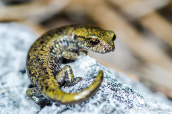Shasta Salamander (Hydromantes shastae)
Description: Adults measure 1 3/4 to 2 1/2 inches long from snout to vent length, and from 3 to 4 1/3 inches in total length. A small stocky salamander with a short tail, webbed feet, a flattened body, and a very long mushroom-like tongue capable of extending out up to 2.4 inches from the front of the mouth. 13 costal grooves, and nasolabial grooves. Not as adapted for crack dwelling as other Hydromantes species with less toe webbing and the body is not as flattened. Dark reddish brown above, mottled with grayish green to tan specks, with some yellow on the tail. Venter is grayish.
Habitat: Found around cliff faces, vertical cavern walls and level ground in mixed forests of Douglas fir, pines, and oaks. Lives in moist caves and rock cracks. Mostly associated with limestone outcrops, but one population has been found in a volcanic outcrop, and others in forest areas with no rock outcrops.
Range: Endemic to California in a fairly small area in the Cascade range near human-made Shasta Lake, Shasta County. Most locations where H. shastae have been found are at elevations between 800 to 2000 feet. In 2007 a single adult was found at 3,800 feet on Bohemotash Mountain in Shasta County.
Found in these States:
CA
Diet: Probably feeds on insects and other small invertebrates.
Reproduction: Little is known about the breeding behavior of this species. Reproduction is terrestrial. Females apparently lay eggs in moist limestone shelters in late summer and brood them until they hatch in late fall. Two clutches of 9 eggs were found in a cave by Gorman in 1956. They would have hatched in late October or early November. Young develop completely in the egg and hatch fully formed.
Status: This species has a very restricted range with an extent of occurrence of 1,242 km2. It occurs mostly on federally protected land, and its population is believed to be stable at present, however there is a current proposal to raise the Shasta Dam and the associated construction could present a future threat to the habitat of this species. In addition, climate change is an increasing threat in this region that could result in decline in the quality of habitat in the future. Lastly, if disease (Bsal) was introduced within its range it could cause significant declines in the population. All of these future threats have the potential to drive this species to Endangered in a very short period of time hence it is currently listed as Near Threatened under criterion D2.
»» Kingdom: Animalia - Animals
»» Phylum: Chordata - Chordates
»» Subphylum: Vertebrata - Vertebrates
»» Class: Amphibia - (Amphibians)
»» Order: Caudata - Salamanders
»» Family: Plethodontidae - Lungless Salamanders
»» Genus: Hydromantes
»» Species: Hydromantes shastae - Shasta Salamander
This article uses material from the Wikipedia article "Shasta Salamander", which is released under the Creative Commons Attribution-Share-Alike License 3.0. Content may have been omitted from the original, but no content has been changed or extended.
|












